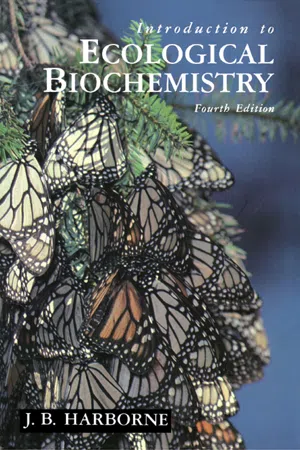
- 384 pages
- English
- ePUB (mobile friendly)
- Available on iOS & Android
Introduction to Ecological Biochemistry
About this book
Ecological biochemistry concerns the biochemistry of interactions between animals, plants and the environment, and includes such diverse subjects as plant adaptations to soil pollutants and the effects of plant toxins on herbivores. The intriguing dependence of the Monarch butterfly on its host plants is chosen as an example of plant-animal coevolution in action.The ability to isolate trace amounts of a substance from plant tissues has led to a wealth of new research, and the fourth edition of this well-known text has consequently been extensively revised. New sections have been provided on the cost of chemical defence and on the release of predator-attracting volatiles from plants. New information has been included on cyanogenesis, the protective role of tannins in plants and the phenomenon of induced defence in plant leaves following herbivory.Advanced level students and research workers aloke will find much of value in this comprehensive text, written by an acknowledged expert on this fascinating subject.- The book covers the biochemistry of interactions between animals, plants and the environment, and includes such diverse subjects as plant adaptations to soil pollutants and the effects of plant toxins on herbivores- The intriguing dependence of the Monarch butterfly on its host plants is chosen as an example of plant-animal coevolution in action- New sections have been added on the cost of chemical defence and on the release of predators attracting volatiles from plants- New information has been included on cyanogenesis, the protective role of tannins in plants and the phenomenon of induced defence in plant leaves following herbivory
Frequently asked questions
- Essential is ideal for learners and professionals who enjoy exploring a wide range of subjects. Access the Essential Library with 800,000+ trusted titles and best-sellers across business, personal growth, and the humanities. Includes unlimited reading time and Standard Read Aloud voice.
- Complete: Perfect for advanced learners and researchers needing full, unrestricted access. Unlock 1.4M+ books across hundreds of subjects, including academic and specialized titles. The Complete Plan also includes advanced features like Premium Read Aloud and Research Assistant.
Please note we cannot support devices running on iOS 13 and Android 7 or earlier. Learn more about using the app.
Information
The Plant and Its Biochemical Adaptation to the Environment
Publisher Summary
I Introduction
| Class | Approx. number of structures | Distribution | Physiological activity |
| NITROGEN COMPOUNDS | |||
| Alkaloids | 10,000 | Widely in angiosperms, especially in root, leaf and fruit | Many toxic and bitter tasting |
| Amines | 100 | Widely in angiosperms, often in flowers | Many repellent smelling; some hallucinogenic |
| Amino acids (non-protein) | 400 | Especially in seeds of legumes, but relatively widespread | Many toxic |
| Cyanogenic glycosides | 40 | Sporadic, especially in fru... | |
Table of contents
- Cover image
- Title page
- Table of Contents
- Copyright
- Foreword
- Preface
- Chapter 1: The Plant and Its Biochemical Adaptation to the Environment
- Chapter 2: Biochemistry of Plant Pollination
- Chapter 3: Plant Toxins and Their Effects on Animals
- Chapter 4: Hormonal Interactions Between Plants and Animals
- Chapter 5: Insect Feeding Preferences
- Chapter 6: Feeding Preferences of Vertebrates, Including Man
- Chapter 7: The Co-evolutionary Arms Race: Plant Defence and Animal Response
- Chapter 8: Animal Pheromones and Defence Substances
- Chapter 9: Biochemical Interactions Between Higher Plants
- Chapter 10: Higher Plant–Lower Plant Interactions: Phytoalexins and Phytotoxins
- SUBJECT INDEX
- INDEX OF PLANT NAMES
- INDEX OF ANIMAL SPECIES